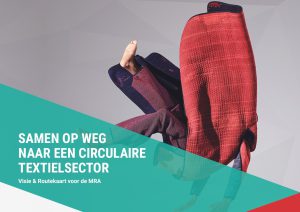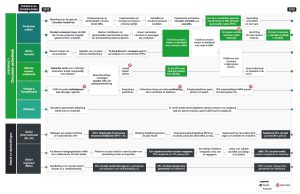Amsterdamse metropool neemt voortrekkersrol in circulair textiel
De Metropool Amsterdam als koploper in een fundamenteel andere, circulaire textielsector: dat is de ambitie van een groot netwerk van bedrijven, overheden en kennisinstellingen uit de regio. Inspirerende circulaire esthetiek en forse opschaling van recycling zijn de speerpunten van de nieuwe visie. Een gesprek met mede-initiatiefnemers Bart Kruijssen (PwC) en Claire Teurlings (Amsterdam Economic Board). “Ik hoop dat bedrijven vanuit intrinsieke motivatie hun businessmodellen eens goed gaan bekijken.”
De Metropool Amsterdam is een vooraanstaande regio op het gebied van textiel en mode. Zo’n kwart van de Nederlandse textielindustrie heeft hier haar thuis en samen zorgen deze bedrijven voor zo’n 10.000 directe en nog eens 10.000 indirecte banen. Maar de sector heeft ook een keerzijde: er zijn veel sociale misstanden in de textielketen en de sector staat in de top 3 van meest vervuilende sectoren ter wereld. De belangrijkste redenen daarvoor zijn CO2-uitstoot, waterverbruik en -vervuiling en afvaIproductie. Alleen al in onze regio wordt jaarlijks zo’n 36 miljoen kilo textiel afgedankt, waarvan tweederde in het restafval eindigt.
Deelnemers aan de Green Deal Circulair Textiel werkten de afgelopen maanden aan een radicaal nieuwe visie op de toekomst van deze veelzijdige sector, op initiatief van de Amsterdam Economic Board, Gemeente Amsterdam en het MRA Bureau. In verschillende sessies werkten bedrijven, overheden en kennisinstellingen in gesprek over deze visie, onder meer in het Experience Center van PwC. Het ambitieuze doel: in 2030 is de textielsector in de regio voor 70 procent circulair, om daarna zo snel mogelijk volledig circulair te worden.
Klik op de afbeelding en lees: Samen op weg naar een circulaire textielsector
Visie & Routekaart voor de MRA
“Maar belangrijker nog dan dit cijfer is dat we een fundamentele verandering in de textielindustrie teweeg brengen”, zegt Claire Teurlings, lead circulaire economie bij de Amsterdam Economic Board. “Met lineair textiel richten we op alle fronten te veel schade aan, dat moet radicaal anders.” “En voor zo’n fundamentele verandering moet je massa maken”, vult Bart Kruijssen, partner bij PwC aan. “Natuurlijk, er zijn kleine initiatieven nodig om te kijken wat wel en niet werkt. Daarvan zien we er gelukkig al veel in de regio. Maar we moeten ook opschalen en om dat weloverwogen te kunnen doen hebben we deze visie en roadmap nodig.”
Dinsdag 19 april nam de Amsterdamse wethouder Marieke van Doorninck de visie en roadmap in ontvangst, tijdens het ‘REFLOW Circular Textile Festival’ in Pakhuis de Zwijger.
Circulaire esthetiek en hoogwaardige recycling
De initiatiefnemers richten zich in hun visie op twee speerpunten: circulaire esthetiek en het opschalen van hoogwaardige recycling. Het eerste speerpunt moet het beeld van mode en textiel veranderen, onder meer door een platform op te zetten dat een inspirerend, circulair modebeeld uitdraagt. Teurlings: “We hebben hier in de regio veel koplopers rondom circulaire mode en we zien dat daar een ander soort mode, een andere soort ontwerptaal ontstaat. We willen op het platform zowel consumenten, ontwerpers als de industrie inspireren, maar ook heel praktische kennis delen over bijvoorbeeld een circulaire supply chain.”
Hoogwaardige recycling bleek in de eerste gesprekken over de visie ook een belangrijk thema. “Dat raakte bij mij een gevoelige snaar”, vertelt Kruissen. “Ik woon in Amsterdam-Zuid en zie hoeveel we met z’n allen consumeren en weggooien. We kunnen echt grote stappen zetten in betere inzameling.” Dat begint bij bewustwording bij consumenten: veel mensen denken dat je alleen goede kleren in de textielbakken mag doen, terwijl vrijwel alle stukken textiel erin mogen — alleen zwaar vervuild textiel niet.
Hoogwaardige recycling gaat ook over het verbeteren van de processen na inzameling, zodat afgedankt textiel weer gebruikt wordt voor textiel en kleding. Teurlings: “Afgedankt textiel gaat nu nog vaak terug naar Azië, maar om de keten circulair te maken moeten we ook dit regionaal gaan doen.” Daar wordt al hard aan gewerkt. Zo ontwikkelde Wieland Textiles de Fibersort, voor het sorteren van textiel en de Fiber Farms van Textiles2Textiles versnijden alle soorten textiel in post consumer clippings, kleine stukjes op kleur en materiaal gesorteerd textiel die weer geschikt zijn voor bijvoorbeeld vervezeling.
Het gaat erom dat we regionaal meer goed recyclebaar textiel inzamelen, legt Kruijssen uit. “Re-use, hergebruik is natuurlijk het best, maar de realiteit is dat we niet alles naar Vinted brengen of kunnen repareren. Als we meer textiel geschikt voor recycling hebben, dan gaat de kostprijs van gerecycled materiaal omlaag en kan de vraag stijgen.”
Bij beide speerpunten speelt verdere digitalisering een belangrijke rol. “Er zijn bijvoorbeeld data nodig om de uitdaging precies in beeld te krijgen, maar ook om de transparantie in de keten te bevorderen”, zegt Teurlings. “Maar digitalisering speelt ook in het ontwerp een belangrijke rol. The Fabricants ontwerpt bijvoorbeeld digitale couture, kleding die je in de digitale wereld kunt dragen zonder dat er maar een stukje textiel aan te pas komt.”
Zendingswerk
De textielbedrijven die meewerkten aan de visie en roadmap zijn de innovatieve koplopers uit de regio, vooral startups en scale-ups, maar ook regionale overheden en onderzoeks- en onderwijsinstellingen. “We gaan nichespelers ondersteunen bij het opschalen van kleine initiatieven”, vertelt Teurlings. “Voor de grotere kledingproducenten is het lastiger om meteen het roer om te gooien. Die doen vaak wel pilots rondom duurzaam textiel, zoals H&M met haar circulaire collectie en inzamelboxen van afgedankte kleding. Maar fundamentele wijzigingen in businessmodellen blijven achter.”
“Daar ligt dus nog wel wat zendingswerk”, zegt Kruijssen. “Veel van die grotere partijen zijn onze klanten of zouden dat kunnen zijn en dat is precies ook de reden dat wij ons bij dit initiatief hebben aangesloten. Het is onze missie om bij te dragen aan duurzame vooruitgang bij klanten en in de maatschappij, en we geloven dat dat gebeurt door bedrijven en instituten bij elkaar te brengen. Bovendien adviseren we onze klanten over hun ESG-doelstellingen en over bijbehorende nieuwe businessmodellen en de financiering daarvan.”
Netwerksturing
De Amsterdam Economic Board is als transitiemakelaar voorzitter van de stuurgroep die het netwerk rondom circulair textiel in de Metropool Amsterdam vertegenwoordigt. Netwerksturing is daarbij het uitgangspunt: dat is een nieuwe en specifiek voor de situatie geformaliseerde structuur waarin iedereen een vooraf afgesproken — en later preciezer ingevulde en eventueel bijgestelde — rol en verantwoordelijkheid vervult in het netwerk, die bijdraagt aan de transitie.
Naast de visie met de twee speerpunten formuleerde het netwerk ook een voorlopige routekaart. Die geeft een overzicht van lopende en geplande initiatieven, beleid, doelstellingen en randvoorwaarden voor een circulaire textielsector. De komende tijd gaan de deelnemende partijen verder met de verschillende deelinitiatieven. Teurlings: “Er is financiering nodig om die verder te brengen, maar ook een model om al die losse initiatieven samen te brengen om zo de hele keten circulair te maken.”
Klik op de afbeelding en check de ‘MRA Textiel Roadmap’
Intrinsieke motivatie
“De hier gekozen aanpak kan een belangrijk voorbeeld zijn voor de circulaire economie als geheel”, verwacht Kruijssen. “Niet alleen omdat het zo’n vervuilende industrie is, maar ook omdat textiel voor een belangrijk deel een consumentenindustrie is. Je maakt zo een grote groep mensen bewust van de uitdagingen en die consumenten zullen ook meer gaan verlangen van andere industrieën. Maar ik hoop eigenlijk dat bedrijven niet wachten op druk van consumenten of strengere regelgeving, maar vanuit hun verantwoordelijkheid en intrinsieke motivatie de houdbaarheid van hun businessmodellen eens goed gaan bekijken.”
Wil jij ook deel uitmaken van de groep koplopers op weg naar circulair textiel? Je bent meer dan welkom om aan te haken met jouw initiatief, connecties en netwerk, financiering(svraag), middelen en kennis. Neem contact op met Claire Teurlings, via c.teurlings@amecboard.com
22 april 2022
Meer weten over
Neem contact op
Blijf jij ook op de hoogte?
8x per jaar nieuws en events uit de regio: schrijf je in voor de Board Update nieuwsbrief
Deel dit artikel
Wil je op de hoogte blijven?
Volg ons dagelijks op LinkedIn en schrijf je in voor de Board Update nieuwsbrief.
Lees ook deze berichten
- Een nieuwe lichting gedreven jongeren is aangetreden bij Young on Board, de ...
- Met de selectie van vier kanshebbers is de regionale voorronde van de ...
- Met meer dan 80 ondernemers, 40 investeerders en diverse dienstverleners bood LSH Capital Match ...



